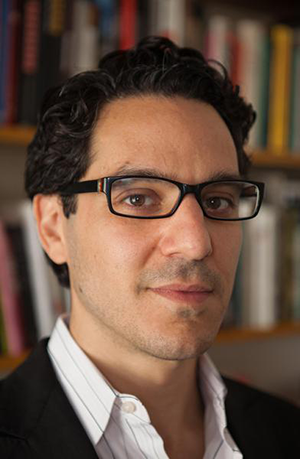Noam Elcott Illuminates the History of Artificial Darkness

Most people walk into a darkened movie theater and think nothing of it. Not Noam Elcott, an associate professor of art history. Elcott (CC’00) has made a study of artificial darkness in venues such as photography darkrooms and darkened cinemas, and he distinguishes such darkness from shade, shadows and night.
“We all know that the moderns mobilized artificial light to conquer the dark,” he said. “Less well known is the fact that they also tried to control darkness.”
In his forthcoming book Artificial Darkness: An Obscure History of Modern Art and Media (University of Chicago Press), Elcott argues that the creation of artificial darkness in the mid-to-late 19th century was crucial to the development of cinema projection, film studios, photography, and stage entertainment of all kinds, including avant-garde theater and art. “It was key in the production, reproduction and reception of images,” he said.
Prior to the 19th century, the auditorium was a place to see and be seen, with house lights rivaling stage lights. The emergence of the stage and a luminous rectangular screen against a controlled dark space are relatively recent developments. “Few know that theaters were not routinely dark until the end of the 19th century,” Elcott said.
Elcott’s study of artificial darkness falls under the rubric of a relatively new discipline in academia called media history and theory. The field gained traction in the 1960s on both sides of the Atlantic with scholars drawing connections among architecture, art, politics, theory, film history and media.
No subject is too obscure for Elcott, who notes the difference between our reaction to the darkness of a haunted house (“We’re hypersensitive to our bodies and surroundings.”) and the darkness of a cinema (“We forget about our bodies and our surroundings.”)
Yet he observes that the screen and darkened room are everywhere in modern life. All one has to do is visit a museum or attend an art festival to find vast amounts of video, cinema and multimedia projections on display.
Meanwhile, older art historical distinctions about different forms of media are starting to crumble, he says. “While painting was an essential component of visual culture into the 20th century, it no longer is,” he said. “Photography and video have grown in importance.”
Elcott became interested in the history of artificial darkness while studying art history at Princeton, where he wrote his dissertation on abstract photography and film in the European avant-garde. He joined the Columbia faculty in 2008.
His interest in art history was kindled with his freshman year Art Humanities course, taught by Stephen Murray, the Lisa and Bernard Selz Professor of Medieval Art History, an expert in Romanesque and Gothic architecture. Other influential mentors were University Professor Rosalind Krauss and Jonathan Crary, the Meyer Schapiro Professor of Modern Art and Theory.
“I learned from Rosalind that art is the most exciting way to see and think about culture,” he said. “I learned from Jonathan that the often invisible systems surrounding art are often as important as the works themselves.”
Having gone from student to faculty member at Columbia, Elcott has come full circle in connection with one of his mentors: Last semester he co-taught a class with Krauss.